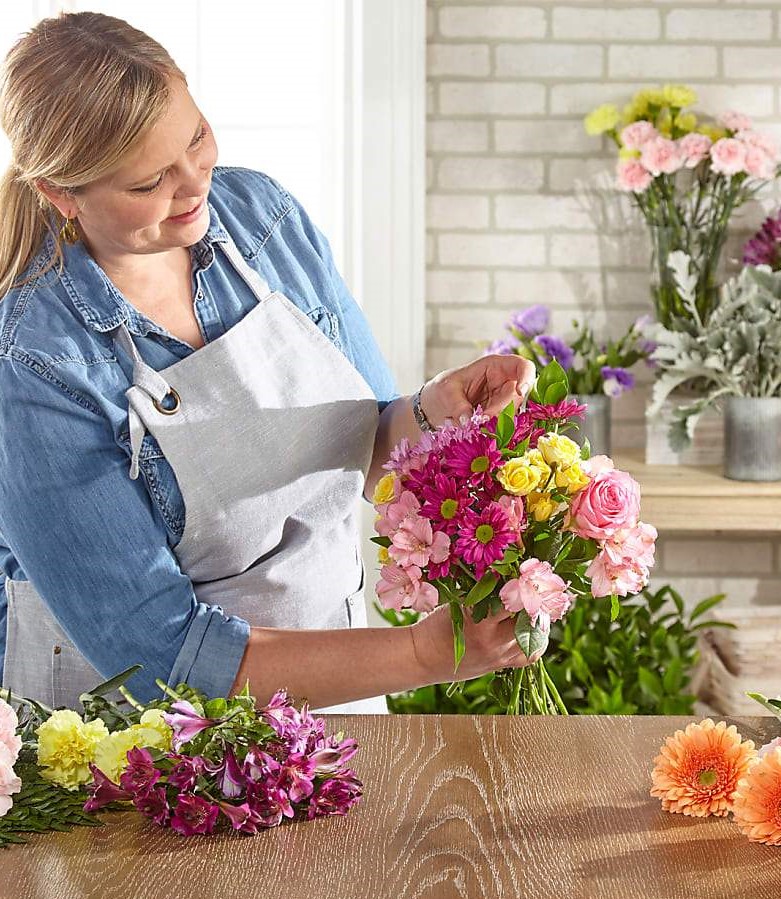Discover the Art of Floral Style: Tips From Expert Florists
Floral layout is not just an aesthetic venture; it is a nuanced art type based in concepts such as balance, percentage, and comparison. Expert flower shops supply vital understandings into choosing the ideal flowers tailored to certain occasions, making sure that each setup resonates with its designated message.
Understanding Floral Design Principles
Commonly forgotten by novice flower shops, recognizing the basic principles of floral layout is essential for producing visually appealing setups (florist lockhart). These principles act as the foundation upon which successful floral structures are built, guaranteeing harmony and equilibrium in each development
Balance refers to the distribution of visual weight within a setup, which can be symmetrical or unbalanced. Contrast, attained through differing colors, forms, and textures, includes interest and deepness to the design.

Rhythm overviews the viewer's eye with the arrangement, often completed by repeating forms or colors. Unity guarantees that all parts of the style job together cohesively, producing a sense of completeness. By mastering these concepts, flower designers can elevate their work, changing easy arrangements right into spectacular aesthetic declarations.
Eventually, a strong grasp of these flower layout principles not only boosts creativity however additionally fosters a deeper appreciation for the creativity entailed in floral plans (florist lockhart). Via practice and application, newbie florists can establish their abilities and develop remarkable designs
Selecting the Right Flowers
Choosing the suitable flowers is an essential action in the flower layout procedure, directly affecting the total aesthetic and efficiency of the setup. To begin, consider the occasion; different occasions require distinctive flower kinds. For instance, enchanting setups might take advantage of roses, while happy parties could match sunflowers or gerbera daisies.
Make use of a shade wheel to identify complementary or comparable shade plans that can produce a natural look. Furthermore, think about the period; seasonal blossoms not only ensure quality yet also commonly come at a reduced price, making them a practical option.
Another crucial aspect is the desired long life of the arrangement. Some blossoms, such as chrysanthemums and carnations, have longer vase lives, while others, like peonies, might shrivel faster. Assess the dimension and shape of the blossoms in relation to your layout goals. Bigger blooms can offer as prime focus, while smaller sized flowers can fill out spaces and add structure. By attentively selecting flowers, you can develop plans that reverberate with their desired purpose and target market.
Techniques for Plan

An additional efficient strategy is the "line design," which stresses the natural lines and shapes of the blossoms. By using long-stemmed blossoms, designers can develop a sense of activity and flow in the plan, attracting the eye along the lines created by the stems. In addition, including varying elevations in the plan adds deepness and interest, enabling the audience to check out the item from various angles.
This approach can evoke particular emotions and established the mood of the arrangement. Don't fail to i thought about this remember the relevance of negative important site space; leaving spaces within the arrangement enables for breathing space, improving the total aesthetic and preventing overcrowding.

Seasonal Floral Inspirations
Integrating seasonal elements into floral layouts can profoundly boost their appeal and relevance. By straightening flower setups with the altering seasons, flower designers can evoke specific moods, motifs, and colors that reverberate with customers and the setting. Each period supplies a distinct scheme of blossoms and foliage that allows for imagination and motivation.
In spring, consider the fragile charm of tulips, daffodils, and cherry blooms, which symbolize revival and vibrancy. Summertime lends itself to vibrant colors and rich structures with sunflowers, peonies, and zinnias, celebrating abundance. Autumn's abundant tones can be captured through dahlias, chrysanthemums, and decorative turfs, developing warm, inviting arrangements that mirror the harvest. Winter season provides a peaceful visual with evergreens, amaryllis, and seasonal berries, best for evoking a sense of tranquility and festivity.
Taking Care Of Your Setups
Looking after floral plans is vital to preserve their beauty and durability. Proper care makes sure that your flowers remain vivid and fresh, enhancing the aesthetic appeal of your space. Beginning by positioning your arrangement in an awesome place, far from direct sunlight and drafts, as extreme temperatures can cause wilting and staining.
Consistently examine the water level in the flower holder, ensuring it is enough to cover the stems sufficiently. Replace the water every few days to protect against microbial growth, which can shorten the lifespan of your plan.
In addition, take into consideration the type of blossoms in your setup; some might need specific treatment. Avoid positioning your plans near ripening fruit, as ethylene gas can accelerate wilting.

Conclusion
To conclude, understanding the art of floral design includes a comprehensive understanding of foundational principles, careful option of blossoms, and the application of effective plan strategies. Seasonal ideas better improve creative go to these guys thinking, while appropriate treatment ensures that flower screens preserve their charm and long life. By integrating these components, individuals can create impactful plans that share feeling and serve their intended objective, ultimately improving the experience of both the creator and the recipient.